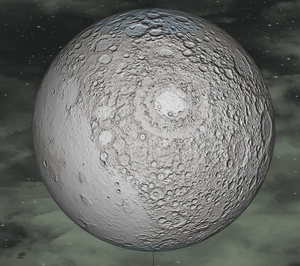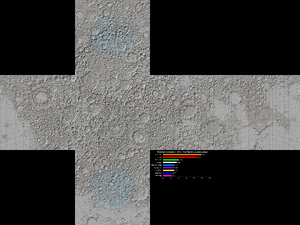Moon
Moon is the name of a small planetary body next to the Earth-like Planet. The satellites (moons) of other planets are called Europa and Titan and are covered on their own pages. The moon is a hard starting location to survive.
You recognise this small gray moon in space by the large blue EarthLike planet next to it.
Terrain
It's a small planetary body with countless steep craters, grey rocks, and grey regolith, and rarely ice.
The terrain is full of steep round craters and hillsides; paired with low gravity, navigating this terrain is hard for small rovers. For space ships however, landing and lift-off will be easy, no atmospheric trusters needed.
Atmosphere
If you are tired of the other planets' storms and fogs, you will enjoy the weatherless, cloudless, airless quiet of the Moon.
It has no atmosphere so wind turbines won't work at all; use solar panels to gain renewable energy, or hydrogen engines. No opening the helmet here, be prepared to bring oxygen.
Trivia
In real life, the Moon is Earth's only natural satellite of significant size. The gravitational effect that the Moon has on the Earth has enough pull to create tidal forces credited for the development of life on Earth. The Moon acts as both a sun light mirror at night, a seasonal water cycle engine, and an asteroid shield for the Earth.
Statistics
- Diameter: 19km
- Surface gravity of 0.25g
- Max Altitude with Gravity: 2,678 meters
- No atmosphere, no oxygen, no clouds
- No flora, no fauna
- No weather
- Temperature: Freezing
Resources:
- Iron, Nickel, Silicon
- Cobalt, Silver, Magnesium
- Ice
- Gold
- Platinum
Map
Gallery
Spoilers
Spoiler warning!
This article or section contains details about the game which players may be intended to discover on their own!
When searching for ore on the Moon, it is most advantageous to look for golden-yellow marked surface streaks usually found near mountains and crater rims. The easiest way to find ice on the Moon is to visit its polar caps.





